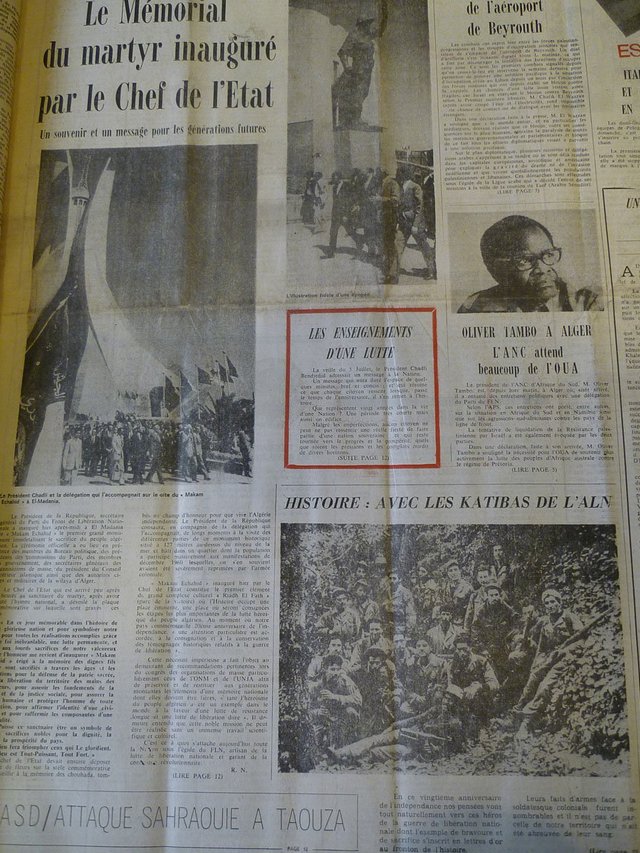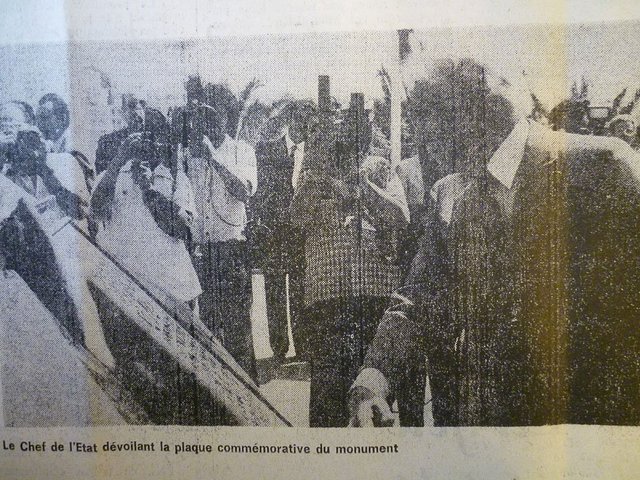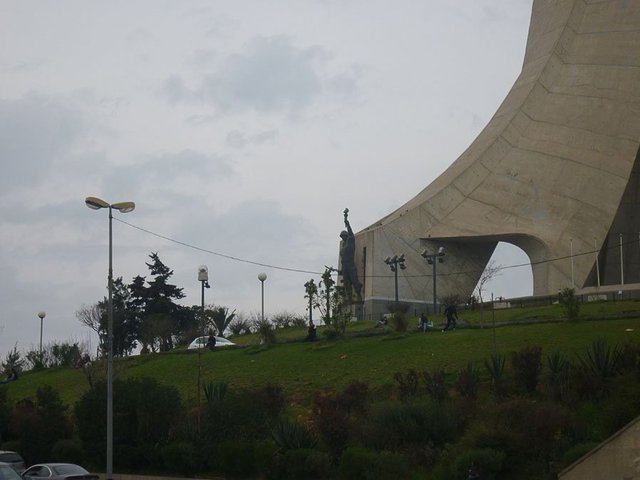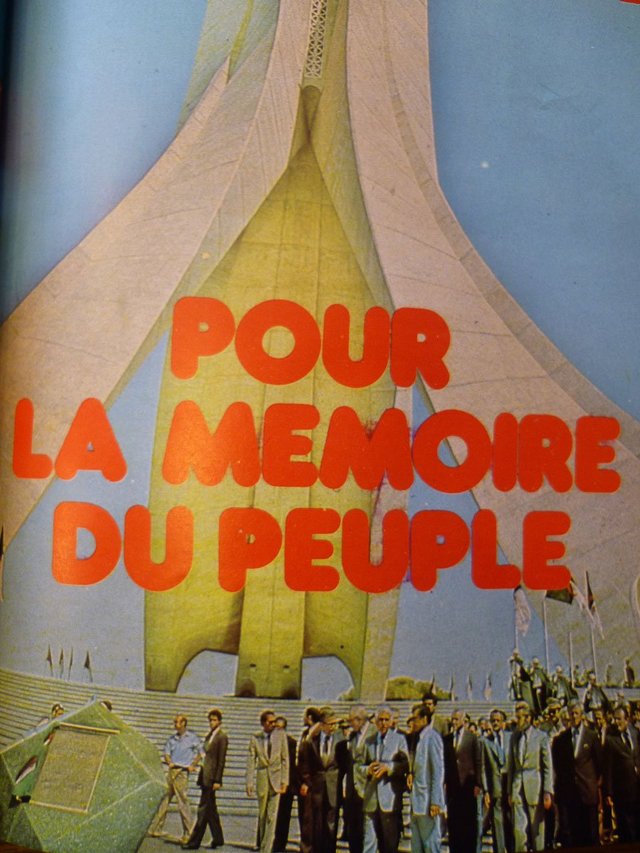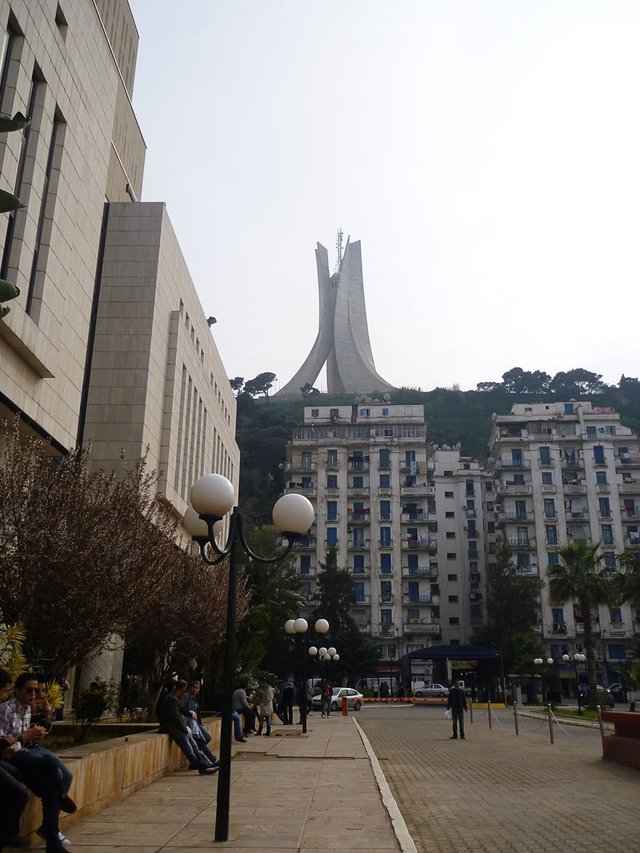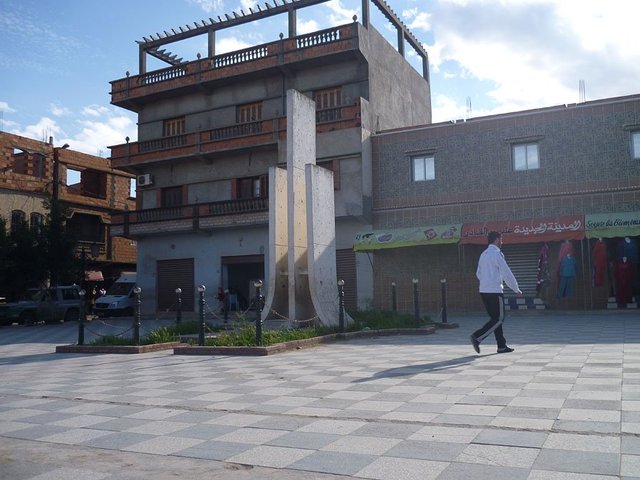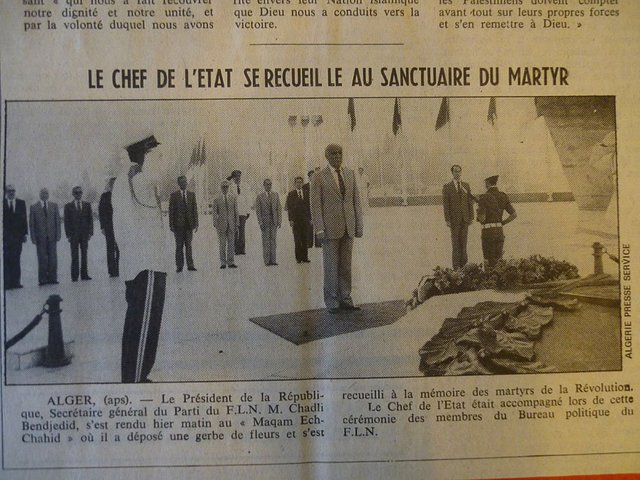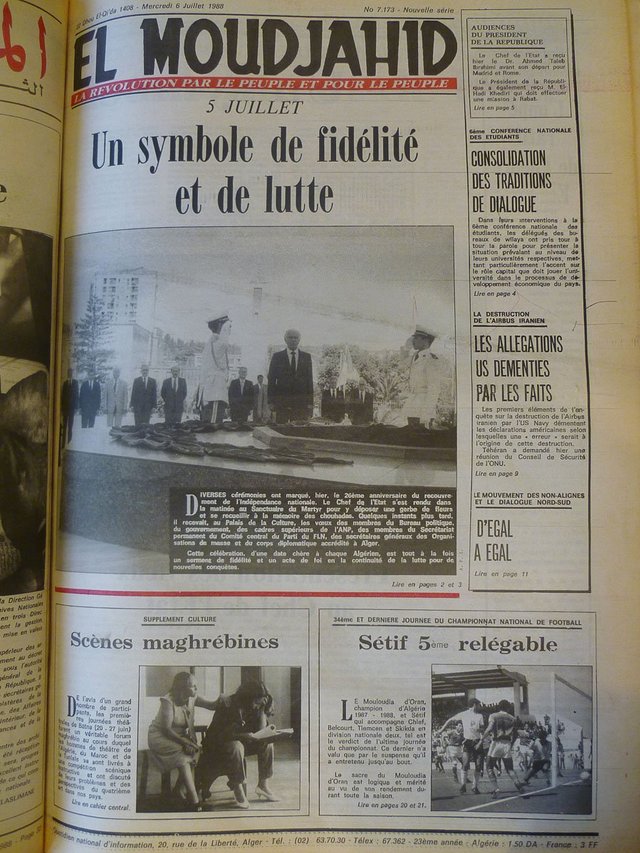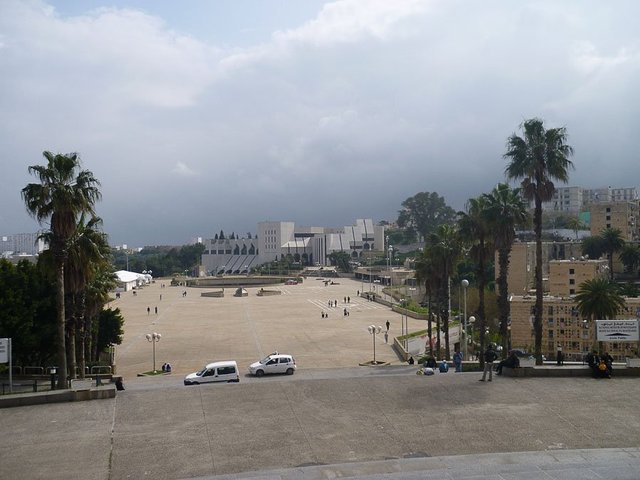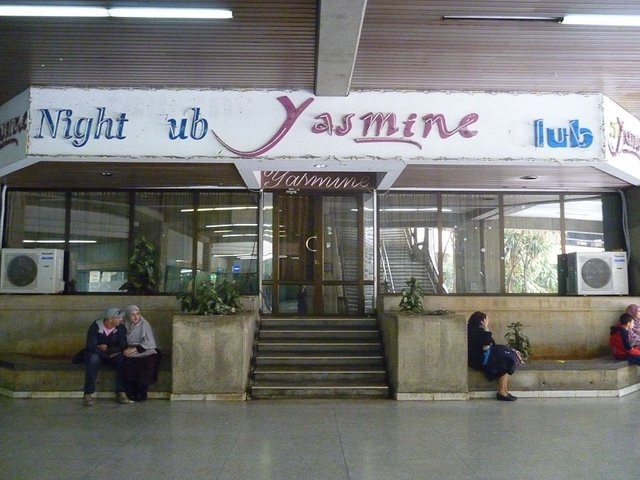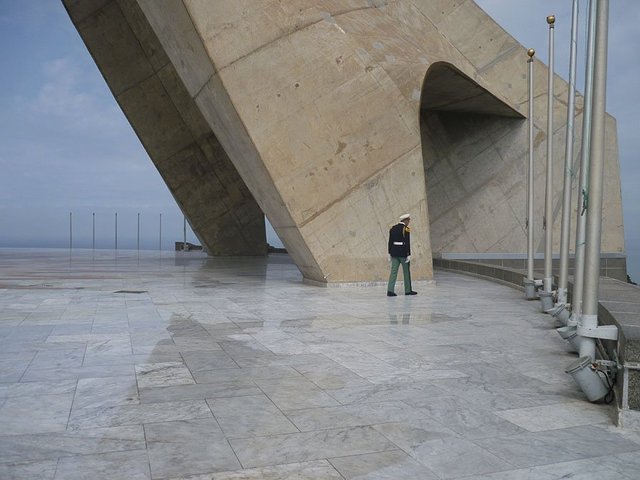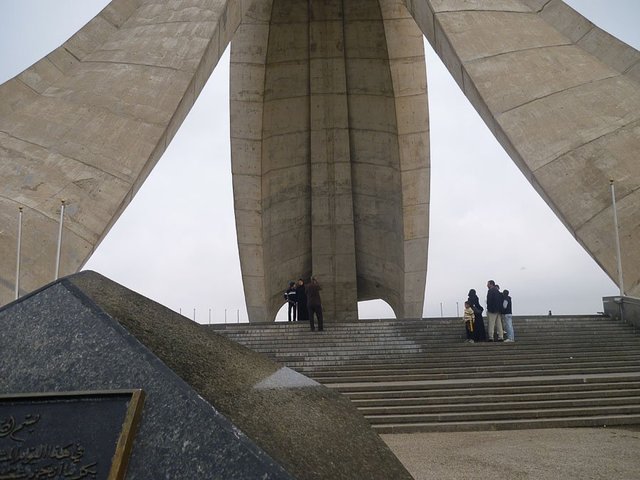Essays
An Explanation of an Irrelevant Monument
On the Memory of a Memorial
In El Madania, southern Algiers, three concrete palm leaves sweep majestically into the sky from a hillside overlooking the city's bay. Visible to anybody who cares to look, this 92 foot monument is The Martyr's Memorial – Maqam El Chahid – unveiled by President Bendjedid Chadli in 1982 to represent national unity and to emphasise the legitimacy of the Front de Libération Nationale (FLN) regime. For Chadli and his audience of appropriately starched and gold-braided politicians and war veterans, the 1982 inauguration of Maqam El Chahid on the 5 of July was a symbolic moment of past and present uniting under the auspices of FLN officialdom. On this day, the twentieth anniversary of Algerian independence, and to the music of the national anthem, the memory of the 'million martyrs' who were killed in the liberation struggle was finally honoured in concrete and mortar to a height that might represent the scale of Algerian suffering throughout history.
As part of the same regeneration project, a commercial centre was constructed directly beneath the memorial and inaugurated in 1986 as a demonstration of Chadli's new economic liberalism. Yet contrary to Chadli's aims, Maqam El Chahid and this commercial centre failed to gain popularity and 30 years on, these obscure and abandoned concrete constructions remain welded into the urban landscape, their walls begging to tell a story. Algeria's most well known narrative is the 1954-62 war for independence. It is the event, interpreted in Algerian historiography as the culmination of 130 years of exploitation and oppression at the hands of French aggressors. The FLN was the umbrella association that spearheaded this finalising war. It reconstituted as a political party at independence and has dominated Algerian politics ever since. FLN legitimacy is embedded in the liberation struggle and demonstrating this heritage has been a priority of the regime's commemoration policies since the 1960s.
One example of these policies are the three idealized statues of a freedom fighter or moudjahid that stand at the base of each of Maqam El Chahid's three palms. These larger than life icons are by implication heroes, martyrs and FLN members that gave their lives unquestioningly for the homeland. They are strong reminders of how easily complex histories of events and individuals can be moulded into commissioned images and monuments that, in this case, hallmark the collective nature of Algerian history as presented by the FLN.
Maqam El Chahid was designed by Algerian artist Bachir Yellès, who began work on blueprints for a national memorial under Algeria's two former presidents. Yellès was commissioned by President Ben Bella (1963-5) to design a war memorial that would pierce the Algiers skyline, while President Boumediène (1965-78) desired a three-sided monument that would represent the three socialist revolutions (industrial, agrarian and cultural) of the post-colonial state. Under President Bendjedid Chadli (1979-92), Yellès integrated these earlier designs to create what was intended to be an impressive symbol of the debt owed to Algeria's martyrs, a representation of progress made since independence and a marker of the state's contemporary innovation.
Following its inauguration, it was described as a 'symbol of the sacrifice of all Algerians, from 1830 and throughout history, who fell in battle for the dignity, the freedom and the independence of Algeria'.[1] It was a 'synthesis of thousands even millions of Algerian resistors who died from generation to generation'[2] as well as a 'symbol to glorify their memory forever' and 'a historical lesson of sacrifice, an example that every citizen must follow'.[3]
The monument's El Madania location was chosen for several reasons. With its inheritance as a French torture ground as well as an Algerian focal point for anti-colonial protests, it appealed to what Paul Nora would classify under the notion of 'lieux de memoire': sites of memory.[4] The site is on high ground overlooking the Bay of Algiers and therefore has a panoramic advantage. Erecting Maqam El Chahid above the bay meant it could be seen throughout Algiers, thus eliminating the need for similarly themed memorials in each of the city's quarters. The monument is visible from every approach to the city – by boat, train and plane – thus facilitating its reputation as an icon of the capital and, indeed, the whole nation.[5]
Miniature reproductions of Maqam El Chahid were also constructed in towns across Algeria. These 'mini-Maqams' homogenised the characteristics of local reference points and brought a new commonality to the Algerian landscape. Such culturally inspired urban planning gave Maqam El Chahid a powerful local and national presence.
Yet despite the combined political and artistic calculations behind the monument's design and manifestation, the intended meanings of the structure are not widely celebrated. That Canadian contractors engineered Maqam El Chahid (and later the commercial centre) is a fact more widely appreciated than the monument's representation of Algerian suffering. Yet for Chadli, the aim was not to create a symbol of Canadian capitalism in the centre of Algiers. Rather, the function of this outsourcing was to complete the Maqam El Chahid project in an efficient six months, which would, by default, demonstrate the possibilities promised by Chadli's 1980 five-year plan, 'Towards a Better Life'.
For Chadli, time was of the essence when building Maqam El Chahid. He had recently gained his presidency after the former President Boumediène's sudden death in 1978. Faced with multiplying protests in the Algerian streets, he needed to authenticate his position quickly. The impending vicenary of the liberation struggle gave him an opportunity to enhance his public profile and to reiterate the alleged unity of the Algerian people.
For the memorial's inauguration ceremony, the FLN mouthpiece, El Moudjahid, presented images of the ceremony alongside several photos of the war for independence. The use of this kind of photographic imagery is a significant example of how the newspaper documented the linear time that defines not only Algerian history but also the national calendar. That is, the history of the independence struggle is told using particular events, which are celebrated through annual remembrance days such as the 5 of July Independence Day. Together, the ceremony and the reporting of it played an important role in the transmission of history, especially to party members who were too young to have experienced the war. They also demonstrated the FLN's control of the presentation of Algeria's past and the party's desire to reinforce its own association with the independence struggle (the fundamental basis of legitimacy).
Between 1981 and 1984, two museums illustrating this shared past were constructed alongside the monument. The Museum of the Moudjahid, which sits below Maqam El Chahid, focuses almost exclusively on Algerian anti-colonial resistance between 1954-62. The scale of resistance is emphasized by a display of several hundred guns, tens of typewriters and other clandestine materials. There are innumerable images of anonymous defenders of the homeland reproduced hundredfold in paintings and figurines throughout the museum: an emphasis on the 'mass' nature of the war subordinating individual memories of the events into a single collective experience.[6]
A short walk away, the larger Central Museum of the Army contains a collection of preserved uniforms, weapons, reconstructions of battle scenes and even near life-size models of military horses, aircraft and tanks. This permanent collection, displayed chronologically over three floors, is a 'dedication to heroism that Algerians have demonstrated [throughout history] in wars against Roman, Byzantine, Vandal, Spanish and French invaders'[7] and it has not altered since the doors of the museum opened.
The third floor of the museum is concerned with the French occupation. Here, the nationalist narrative is omnipresent. One papier-mâché model – about 30 square inches in size - reconstructs mass immolations of civilians by French officials during the Sétif and Guelma massacres of May 1945. Algerians are presented captive in an animal pen and being marched to a cave in which a fire is stoked. This model, adjacent to a painting that depicts bodies being thrown off a cliff into a pit of blood and dismemberment, is emblematic of the political nature of Algerian cultural expression and heritage conservation. Such illustrations of French cruelty are contrasted to images of Algerian vulnerability and implied military and moral superiority.
The ground floor features rotating temporary exhibitions that celebrate the seven commemorative events of the Algerian calendar, those that El Moudjahid is always sure to flag: Martyr's Day, Ceasefire Day, Independence Day, War of Independence Day, May 1945, Paris 1961 and Algiers 1960.[8] The Central Museum of the Army therefore was and remains a tribute to Algerian patriotic history,[9] reducing moments of conflict across several historical periods into a single legendary struggle, 'la [sing.] lutte légendaire', itself reduced into seven memorialized events.
But what differentiates this case study of Maqam El Chahid from other state-led, systematic architectural and visual representations of teleological narratives is the construction next to Maqam El Chahid and its museums of a cultural-cum-commercial centre completed in 1986. This centre was ambiguously named 'the Arts Centre': an entertainment hub that boasted 142 shops, 27 restaurants, three cinemas, two conference rooms, an art gallery and even a nightclub. This incongruous combination of memorial and what was essentially a shopping centre demonstrated the FLN regime's desire to adapt an existing policy of commemoration to contemporary political pressures.
By specializing in luxury items such as high quality clothing and electronic goods, the Arts Centre visibly suggested spending and private accumulation. It demonstrated the domestic shift away from former President Boumediène's austerity to Chadlian consumerism, in itself a gross amendment to the previous terms of the state-society contract. Maqam El Chahid and the Arts Centre together represented an increase in government concern with the people's welfare. In press releases, the Arts Centre was presented as a welcoming and idyllic environment that was equipped for all ages, genders and classes: for families, and couples, shoppers and artists.
In theory, this new (public) space existing under the patriotic shadow of Maqam El Chahid created a literal and metaphorical common ground: a 'sense of unity' for people with varying interests. The final complex, incorporating a memorial, two museums and the Arts Centre aimed to be, as one slogan put it, 'open to all'.[10]
The active promotion of pastimes for different groups is suggestive of a need at the time to appease an increasingly vocal and dissatisfied Algerian people. However, Maqam El Chahid and the Arts Centre failed to gain popularity. Their intended nationalist symbolisms, transmuted in popular reception, resulted in readings that were far removed from the plans of their commissioners and designers. The El Madania site quickly became known as a 'bourgeois oasis' described by Algerians as a 'tchi-tchi' (derogatory use of the French 'chic') retreat. Critics condemned the exclusivity of the Arts Centre, accessible only to inhabitants of the nearby upper class neighbourhoods (such as Hydra and El Biar) whose children were enrolled in IT classes and whose wives regularly attended aerobics. Rumours even spread of a shop that sold caviar and champagne (hitherto unavailable in Algeria) to a regulated clientele of diplomatic personnel.
While suggestive of a generally popular economic re-orientation, the combined space of the Arts Centre and Maqam El Chahid was understood to be representative of an unattainable lifestyle reserved only for the favoured few. This was compounded by the site's location. El Madania is three miles from the centre of town at the top of a steep incline. Two cable cars running up and down the hill have serviced the area since its genesis, but their drop off points are still two miles outside the city centre. The area is located near an extended highway that descends towards the Bay of Algiers and while it is equipped with a seven storey car parking facility (the first of its kind in Algeria), owning a car in 1980s Algeria was a luxury. Access to El Madania therefore inspired a sort of determined elitism.
Chadli's policies of liberalism, decentralization and privatization were synonymous with the inconsistent relaxation of regulations and the questionable accumulation of private wealth. By the mid 1980s, the regime was notoriously known for cronyism and corruption. Economic mismanagement was compounded by the collapse of international oil prices in 1986. A black market economy thrived and Algerian debt soared. Such conditions provoked protest among activists who coordinated themselves most successfully at the time around Muslim student organisations.
The paradox of inaugurating a bling Arts Centre just as oil prices tumbled (reducing Algeria's GDP by 50 per cent) was not lost on Algerians. They came to see the monument not as a symbol of debt owed to the martyrs and founders of the nation but of a much more immediate debt owed to international financiers. Within a few years if its inauguration, the commercial premises in the Arts Centre were sold to private buyers. Press reports suggested that government officials had personally profited from the deal. Complaints were made concerning missing foreign exchanges, equipment and invoices. Yet despite these 'violations of the law' having been conducted 'in full view of everyone' there is no record of perpetrators being brought to trial. Consequently, in its proximity to the Arts Centre, Maqam El Chahid was decried in the 1990s as the 'the monument of scandals':[11] a concrete image of the state's economic inefficiency, criminality and, ultimately, its illegitimacy.
As the 1980s drew to a close, demands for reform overwhelmed the state. These materialized most famously in the October 1988 protests that saw thousands of demonstrators filling the streets across the country. In their aftermath, Algeria's first plural elections were scheduled with results in 1991 – amidst boycotts and uncertainty – revealing the Islamic Salvation Front to be the most successful candidate. That same year, loudspeakers at mosques near to the Arts Centre denounced the songs of Madonna and Michael Jackson that played on the video screens inside the Art Centre. Those who worshipped these pop singers like false idols were also included in the criticisms.
[12] In this, the inveighing voice of the mosque was added to a growing public condemnation of the site.
For religious activists, the state's reputation was only worsened by its original sponsorship of this irrelevent area. Criticism over the memorial was expressed through the monument's nickname, 'Houbel', referring to a pre-Islamic pagan idol, becoming far more popular than the title Maqam El Chahid in common parlance. Nowadays, the religious connotations of the nickname 'Houbel' have blended with developing interpretations of the monument: when asked to define 'Houbel' some now claim it means: 'a thing of madness'.[13]
In 1992, the election results were annulled and the Algerian military declared a state of emergency. This ushered a period of obfuscatory violence in Algeria, better known as the 'Algerian civil war' or the 'dark decade', that sealed the fate of Maqam El Chahid and the Arts Centre. During this period, leisure spaces were largely vacated and it was rumoured that Maqam El Chahid and its surroundings had become a target for Islamist attackers. Shopkeepers, already under financial strain, fled the area and restaurants were boarded up. Only a handful of enterprises stayed open in the Arts Centre, in particular its nightclub, pictured below, its reputation as dirty as its neglected windows.
As an open space with no natural defenses, the memorial was insecure: roadblocks and guards swarmed the concrete terrain destroying any trace, if it ever existed, of an idyllic or welcoming recreation ground.
Today, guards, roadblocks and the site's visible desolation have become a permanent feature of Maqam El Chahid. Visitors are still denied the liberty of using this space at will: a viewing point of Algiers from inside one of the palms is closed to unofficial callers and the terrace under the monument is also prohibited to visitors who likewise cannot sit on the stairs directly in front of the monument. While the general consensus is that these security measures are a post-1990s phenomenon, there is no certainty if the general public ever have been or ever will be granted the free use all the monument's functions. For Algerians, Maqam El Chahid is now just another example of the government's failure to provide adequate public space to the people.
The FLN's intention to display political legitimacy, progress and increasing prosperity through the development of this site was a monumental failure: Chadli's architectural dreams instead served the sole purpose of demonstrating the distance between state and society: the exact disenfranchisement the protestors of October 1988 lamented. What remains is a barren grey concrete site that repels visitors with its eerie desolation.
In the end, even as its intended and received symbolisms have slipped away, Maqam El Chahid, through its imposing insistence, remains a solid feature of the Algerian landscape. Despite this, the monument, along with its museums and its shopping centre, have become irrelevant.
Nation: the Struggle Over the Past in Zimbabwe,' Journal of Southern African studies 30.2 (2004).

